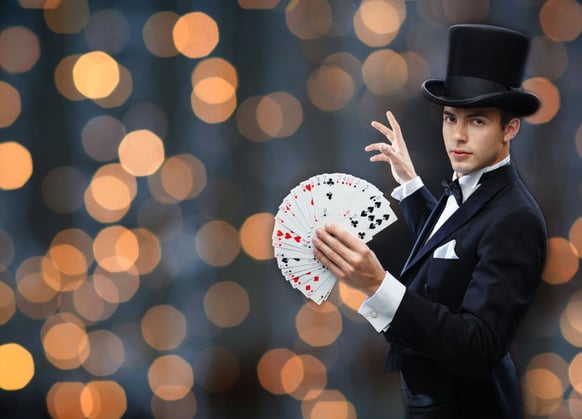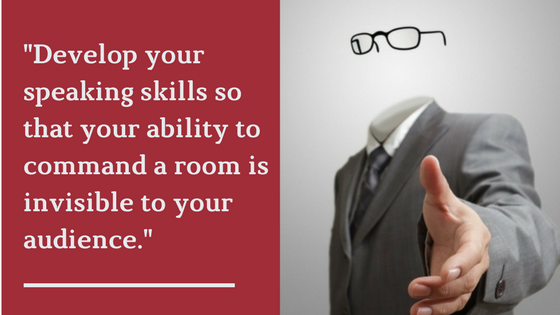
Want to dazzle audiences with your presentations? Learn these amazing 'tricks' from magicians and actors that will boost your own on-stage magic. No kidding!
Let's talk actors and magicians and creating your own on-stage public speaking magic.
You do want to amaze your friends and family and be a hit at parties, don't you? Okay, that last part was tongue-in-cheek. And the title of this piece is me having fun about the vintage magazine ads inviting readers to study magic and become the Houdini of the neighborhood.
But my point is serious: There's a trick you can learn from magicians, and one that actors can teach you, to become a speaker who can dazzle audiences while making it all seem effortless.
Ready to achieve some stage presence of your own? Discover how to unlock your natural talents as a communicator. Get the guide that will help you build credibility, earn trust, and stand out for all the right reasons. Perform at your best in every situation! Download my essential public speaking e-book, 12 Easy Ways to Achieve Presence and Charisma.
You may not acquire x-ray vision, but you'll have audiences perceiving you in an entirely different way.

Learning to Make Your Public Speaking Skills Invisible
Do you know why magicians practice a trick thousands of times? (I don't know whether Malcolm Gladwell's rule of 10,000 hours needed to perfect a task, as specified in his book Outliers applies. But you can rest assured that the actual hours of practice lies somewhere between "very, very many," and "excrutiating" from an outsider's point of view.)
All of this effort involves the pursuit of precision and perfection, of course. But the real Holy Grail of all feats of magic is invisibility. Sleights of hand are usually spoken of in terms of misdirection, for that's the effect that makes the magic trick possible. But misdirection only involves the mechanics of the trick. The actual "magic" of the illusion lies in our response: "That's impossible. I didn't SEE anything happening!"
The magic you weave as a speaker depends upon the same ability to effortlessly demonstrate your command of both material and audience response. All of it, in other words, should be invisible. But this is magic you can realistically achieve through the sweat-equity of practice (naturally), and also with the help of time. Once you've learned dynamic platform skills, ideally through some close 1:1 coaching from a knowledgeable teacher, start to make them a new habit. Here's more on how to make your presentation into a great performance.
With enough hours in, all those skills will be at your command with no premeditation on your part. You'll be able to focus totally on your message and your audience. At that point, your ability to command a room may indeed seem magical to your audience. Perhaps to you, as well.

The Key Acting Technique for Public Speaking
Actors are no less obsessive than magicians when it comes to perfecting a moment on stage or on the screen. The great vaudeville and silent film stars like Charlie Chaplin and Buster Keaton, and even more modern television comedians like Red Skelton were relentless in their repetition of "bits" to get the timing and comic effect right. Even today, actors will work long hours with a prop or on a line reading—or even a facial expression—to achieve the effect they're aiming for.
They work like this because they understand that the perception of the character or moment from the audience's point of view is the quintessence of the actor's art. Despite the over-emphasis of "the Method" in American acting on using personal experiences in understanding a role, the key exchange of an actual performance is between actor and audience, not, after all, between the actor and himself!
The same is true in your speeches and presentations, of course: What matters isn't so much what you think or feel about your topic, as what you get listeners to perceive about you and what you're saying. (I don't mean by this that you shouldn't be honest with audiences, only that in the end, it's listeners' responses that matter most.) And that means externalizing your thoughts and emotions so audiences "get it." Find out more about why great speaking depends upon performance over content.
Externalizing. Audiences aren't mind readers. They need you to show what you think and feel, and to hear it in your voice. This, then, is the key technique that actors use that public speakers must acquire. Information—data—can never carry the load on its own. It needs you as the speaker to make it live, through body language and the other nonverbal skills. So once again, work with someone, preferably an actor, who will show you how to externalize.
So act now, valued magazine subscriber. Send away for the toolbox that will make you a magical speaker. . . . Don't delay!
You should follow me on Twitter here.



